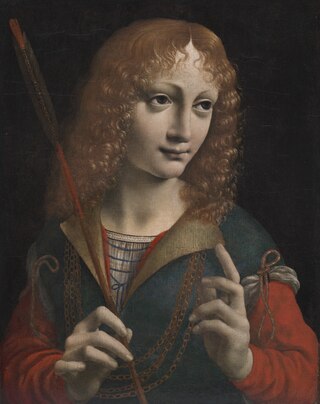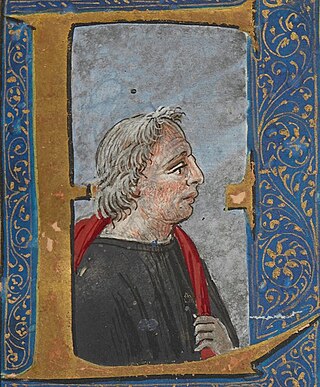
Classics or classical studies is the study of classical antiquity. In the Western world, classics traditionally refers to the study of Classical Greek and Roman literature and their related original languages, Ancient Greek and Latin. Classics also includes Greco-Roman philosophy, history, archaeology, anthropology, art, mythology and society as secondary subjects.

A historian is a person who studies and writes about the past and is regarded as an authority on it. Historians are concerned with the continuous, methodical narrative and research of past events as relating to the human race; as well as the study of all history in time. Some historians are recognized by publications or training and experience. "Historian" became a professional occupation in the late nineteenth century as research universities were emerging in Germany and elsewhere.

The Renaissance is a period of history and a European cultural movement covering the 15th and 16th centuries. It marked the transition from the Middle Ages to modernity and was characterized by an effort to revive and surpass the ideas and achievements of classical antiquity. Associated with great social change in most fields and disciplines, including art, architecture, politics, literature, exploration and science, the Renaissance was first centered in the Republic of Florence, then spread to the rest of Italy and later throughout Europe. The term rinascita ("rebirth") first appeared in Lives of the Artists by Giorgio Vasari, while the corresponding French word renaissance was adopted into English as the term for this period during the 1830s.

The Dark Ages is a term for the Early Middle Ages, or occasionally the entire Middle Ages, in Western Europe after the fall of the Western Roman Empire, which characterises it as marked by economic, intellectual, and cultural decline.

Renaissance humanism was a worldview centered on the nature and importance of humanity, that emerged from the study of Classical antiquity. This first began in Italy and then spread across Western Europe in the 14th, 15th, and 16th centuries. During the period, the term humanist referred to teachers and students of the humanities, known as the studia humanitatis, which included the study of Latin and Ancient Greek literatures, grammar, rhetoric, history, poetry, and moral philosophy. It was not until the 19th century that this began to be called humanism instead of the original humanities, and later by the retronym Renaissance humanism to distinguish it from later humanist developments. During the Renaissance period most humanists were Christians, so their concern was to "purify and renew Christianity", not to do away with it. Their vision was to return ad fontes to the simplicity of the Gospels and of the New Testament, bypassing the complexities of medieval Christian theology.

Carl Jacob Christoph Burckhardt was a Swiss historian of art and culture and an influential figure in the historiography of both fields. He is known as one of the major progenitors of cultural history. Sigfried Giedion described Burckhardt's achievement in the following terms: "The great discoverer of the age of the Renaissance, he first showed how a period should be treated in its entirety, with regard not only for its painting, sculpture and architecture, but for the social institutions of its daily life as well."

The Italian Renaissance was a period in Italian history covering the 15th and 16th centuries. The period is known for the initial development of the broader Renaissance culture that spread across Western Europe and marked the transition from the Middle Ages to modernity. Proponents of a "long Renaissance" argue that it started around the year 1300 and lasted until about 1600. In some fields, a Proto-Renaissance, beginning around 1250, is typically accepted. The French word renaissance means "rebirth", and defines the period as one of cultural revival and renewed interest in classical antiquity after the centuries during what Renaissance humanists labelled as the "Dark Ages". The Italian Renaissance historian Giorgio Vasari used the term rinascita ("rebirth") in his Lives of the Most Excellent Painters, Sculptors, and Architects in 1550, but the concept became widespread only in the 19th century, after the work of scholars such as Jules Michelet and Jacob Burckhardt.
Cultural history records and interprets past events involving human beings through the social, cultural, and political milieu of or relating to the arts and manners that a group favors. Jacob Burckhardt (1818–1897) helped found cultural history as a discipline. Cultural history studies and interprets the record of human societies by denoting the various distinctive ways of living built up by a group of people under consideration. Cultural history involves the aggregate of past cultural activity, such as ceremony, class in practices, and the interaction with locales.It combines the approaches of anthropology and history to examine popular cultural traditions and cultural interpretations of historical experience.

The Story of Civilization (1935–1975), by husband and wife Will and Ariel Durant, is an 11-volume set of books covering both Eastern and Western civilizations for the general reader, with a particular emphasis on European (Western) history.

Heinrich Wölfflin was a Swiss art historian, esthetician and educator, whose objective classifying principles were influential in the development of formal analysis in art history in the early 20th century. He taught at Basel, Berlin and Munich in the generation that saw German art history's rise to pre-eminence. His three most important books, still consulted, are Renaissance und Barock (1888), Die Klassische Kunst, and Kunstgeschichtliche Grundbegriffe.

Ernst Peter Wilhelm Troeltsch was a German liberal Protestant theologian, a writer on the philosophy of religion and the philosophy of history, and a classical liberal politician. He was a member of the history of religions school. His work was a synthesis of a number of strands, drawing on Albrecht Ritschl, Max Weber's conception of sociology, and the Baden school of neo-Kantianism.

Georg Voigt was a German historian who was born in 1827 in Königsberg in East Prussia. He died in Leipzig in 1891. Voigt was the son of the historian Johannes Voigt. Voigt belonged to the founders of modern research into the Italian Renaissance along with Jacob Burckhardt.

Titus Burckhardt was a Swiss writer and a leading member of the Perennialist or Traditionalist School. He was the author of numerous works on metaphysics, cosmology, anthropology, esoterism, alchemy, Sufism, symbolism and sacred art.

Lynn Thorndike was an American historian of medieval science and alchemy. He was the son of a clergyman, Edward R. Thorndike, and the younger brother of Ashley Horace Thorndike, an American educator and expert on William Shakespeare, and Edward Lee Thorndike, known for being the father of modern educational psychology.

Wilhelm von Bode was a German art historian and museum curator. Born Arnold Wilhelm Bode in Calvörde, and known as Wilhelm Bode for most of his career, he was ennobled in 1913, and thereafter adopted the aristocratic "von". He was the creator and first curator of the Kaiser Friedrich Museum, now called the Bode Museum in his honor, in 1904.

Gian Galeazzo Sforza, also known as Giovan Galeazzo Sforza, was the sixth Duke of Milan.

Vespasiano da Bisticci was an Italian humanist and librarian of the early Renaissance period.

The Italian poet Petrarch wrote about his ascent of Mont Ventoux on 26 April 1336 in a well-known letter published as one of his Epistolae familiares. In this letter, written around 1350, Petrarch claimed to be the first person since antiquity to have climbed a mountain for the view. Although the historical accuracy of his account has been questioned by modern scholars, it is often cited in discussions of the new spirit of the Renaissance.
Peter John Murray was a British art historian and the Professor of History of Art at Birkbeck College, London from 1967 to 1980. Together with his wife, Linda Murray, he wrote primers on Italian Renaissance art which have been used by generations of students. In 1959 they published the highly successful Penguin Dictionary of Art and Artists, which was frequently updated and reissued. In 1963, they published two substantial introductory texts The Art of the Renaissance, and a book that became a classic primer The Architecture of the Renaissance.
Henk Schulte Nordholt was an art history professor and scholar from the Netherlands. He studied German language and literature, history, and art history at the University of Amsterdam from 1932 until 1939 and then taught German and history at the Rijnlands Lyceum in Wassenaar. He earned a doctorate under Jan Romein (1893-1962) in 1948 from the University of Amsterdam and wrote a historiography of the Renaissance. He admired Jacob Burckhardt.

















